Since opening its doors in 2020, JCAF has imagined a different kind of museum. A “museum as a thinking protocol” is the founding ethos, and its 2024 curatorial project, Ecospheres, moves assuredly in this direction.
Now embarking on its second three-year research theme, JCAF is coming into its own as an invaluable local institution and community space. Ecospheres is the first exhibition in the Worldmaking series, with the natural world as its focus. The term 'worldmaking' was coined by philosopher Nelson Goodman to highlight his belief that, without representation, nothing can be said or seen. According to Goodman, “Worlds are made by making […] versions with words, numerals, pictures, sounds, or other symbols of any kind in any medium.”
“Worlds are made by making […] versions with words, numerals, pictures, sounds, or other symbols of any kind in any medium.”
And so when JCAF’s executive director Clive Kellner asks, “What kind of world do we want to inhabit?”, a multimedia exhibition that speaks to the primordial elements of Water, Air, and Earth across multiple layers of understanding, from the material to the spiritual, makes sense as a response.
Ecospheres is a useful accompaniment to thinking through our place in the world, particularly regarding stewardship and living together for the mutual benefit of all. What is refreshing is that no hard and fast answers are offered up – only ample space to explore. The museum's division into three 'Atmosphere Rooms' dedicated to Water, Earth, and Air creates a series of distinct, yet subtly interconnected areas for us to engage with these elemental forces anew.
Stepping into the darkened exhibition space from the brightly lit foyer, aromatic spices fill the air – soon revealed to be originating from Brazilian artist Ernesto Neto’s large-scale fabric installation Um dia todos fomos peixes (One day we were all fish). The knitted blue net forms a delicate canopy above and casts shadows underfoot. Inspired by Neto’s life-long fascination with the ocean, it evokes the feeling of being underwater and is our first point of entry into the exhibition’s meditation on Water in Atmosphere 1.
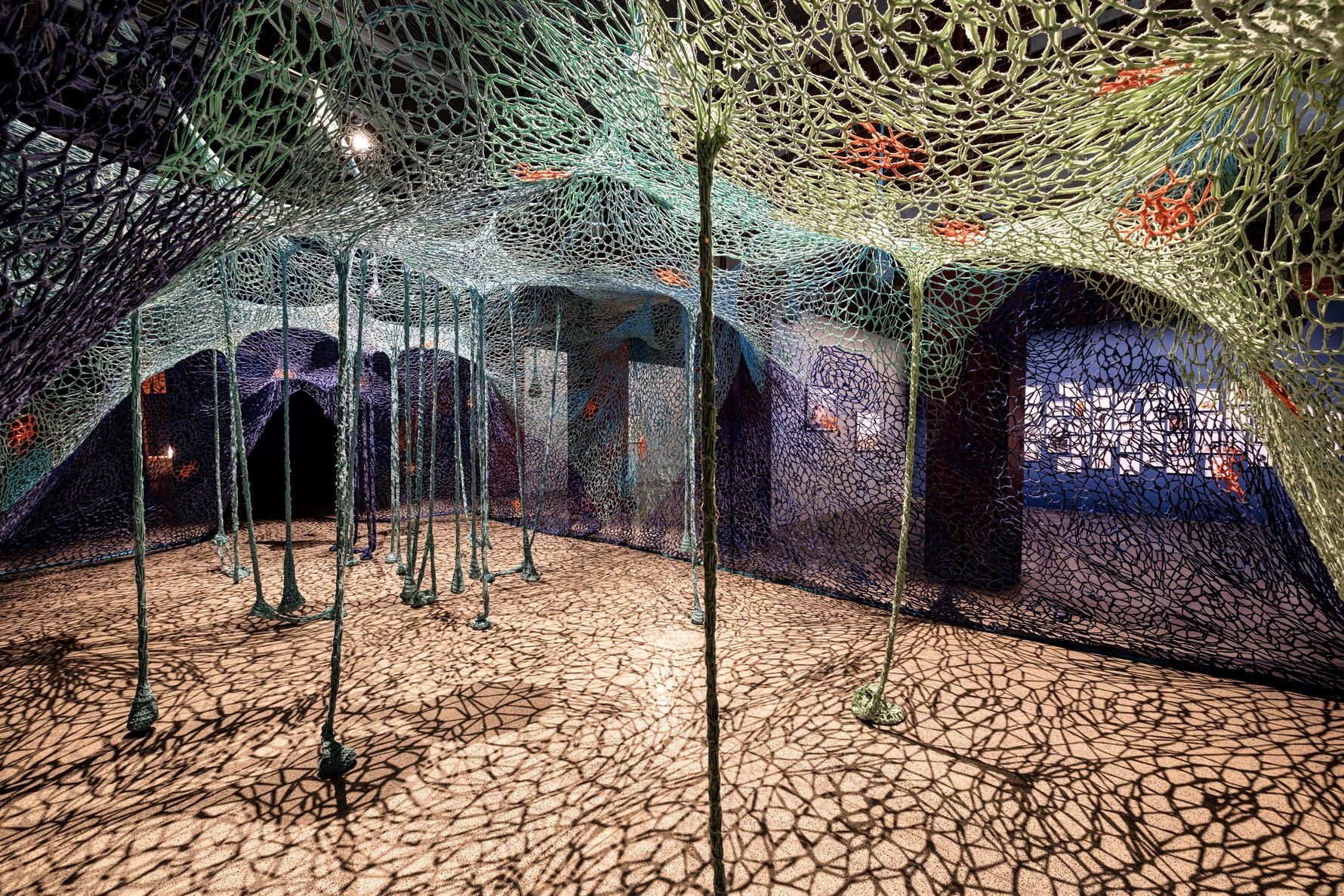
Water is both life-sustaining and symbolically potent. Rather than heightening our awareness of this precious resource, our fundamental reliance on water for practical uses generally means we engage with it as a given; although we notice when it’s not present. Inside Neto’s sensory structure, it becomes easier to allow our minds to wander along the currents of myth and folklore, considering water both literally as a force that carries and contains, but metaphorically too. In so many ways, water is a conduit for communities and cultures.
In her watercolour and ink work, Transtidal, Mumbai-born Rithika Merchant highlights the duality of water in terms of the devastation of flooding and its supportive qualities as a means of transportation and a source of food. From another perspective, ceramic artist Zizipho Poswa’s phenomenal hand-coiled sculpture uNa’kaMzingisi (Mzingisi’s Mother) can be seen both in terms of the traditional water-carrying vessels of the Xhosa people and the way women also carry new life into the world.
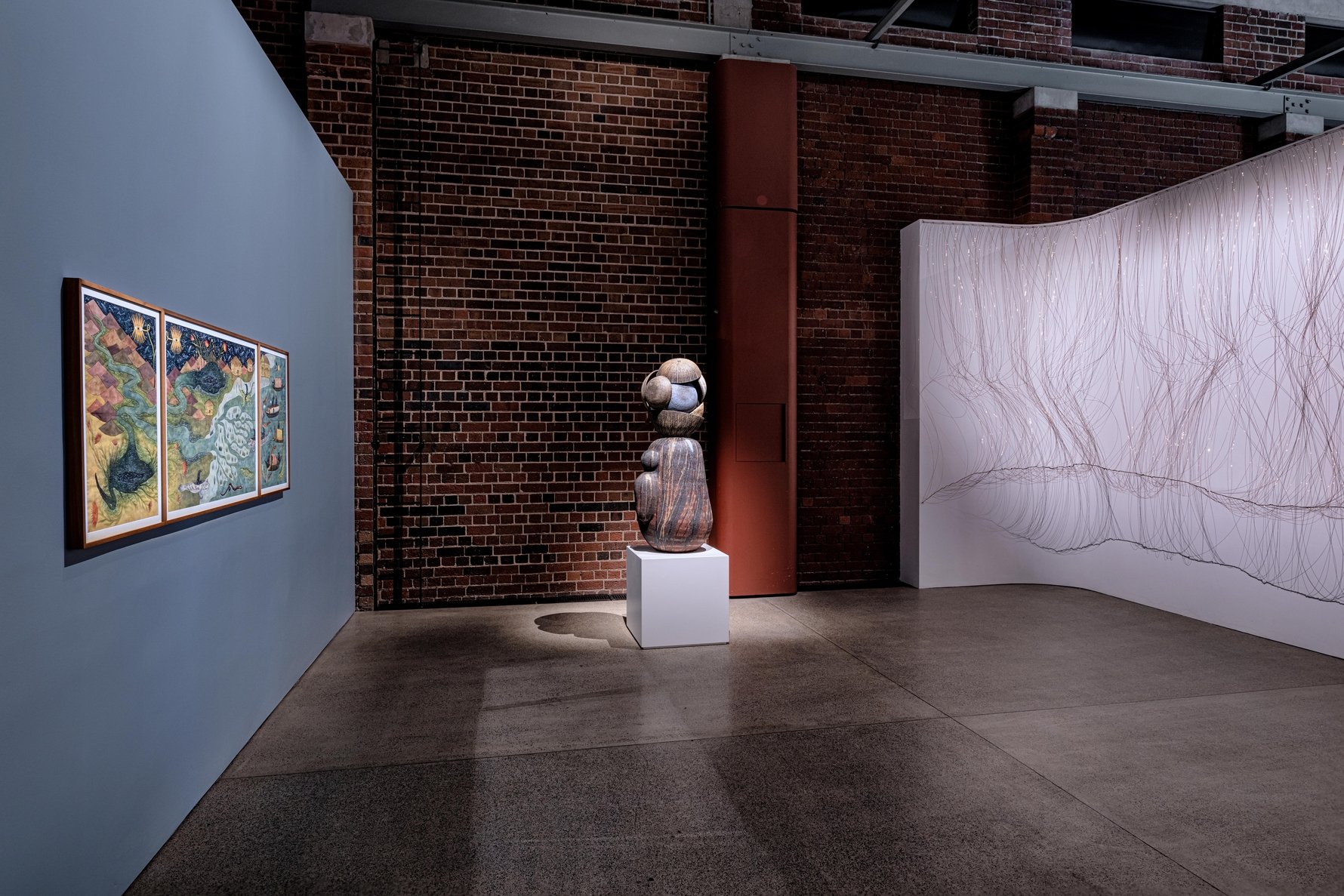
Moving into Atmosphere 2, Air is invoked around themes of migration, diaspora, and kin. British- Indian artist Sutapa Biswas’s Time Flies dedicates a wall to the winged creatures – real and imaginary – who navigate by air and follow natural patterns of migration. Below the surface, these small acrylic and pencil works allude to diasporas and the migratory paths that human cultures follow too, often for reasons far less benign and, as such, accompanied by grave loss.
Our exhibition guide, Maxine Maistry, contextualised the works by saying, “Breath connects us because we all engage in the process of breathing. Migration can happen on very big scales in terms of physically moving, but it can also happen on very small scales through breath and how our stories migrate with us as we talk.” This notion adds weight to our increasingly polluted atmosphere, particularly in urban areas, that compromises the air we breathe.
In Nerea Calvillo’s essay Particular Sensibilities in the Ecospheres reader, the author writes, “The air just above the ground, the troposphere, the messy space where we breathe and live along with other beings, is not a heroic space to be conquered or a space of great disasters, but one of routines. It is an air that is different in every corner and circulates in unexpected ways, where the differences of environmental injustice are more palpable. We cannot escape this air. It is the air that comes into our body through our lungs. It is the air that is part of our urban ecologies and territories, filling our open public spaces.”
Calvillo continues, “This thin section of the atmosphere has materiality, yet one which we cannot normally see with our eyes. To study it, the infrastructures, devices, practices, and bodies that make the air visible become an intrinsic part of this.” Science is one way to render the invisible through numbers and concentrations. Art is another.
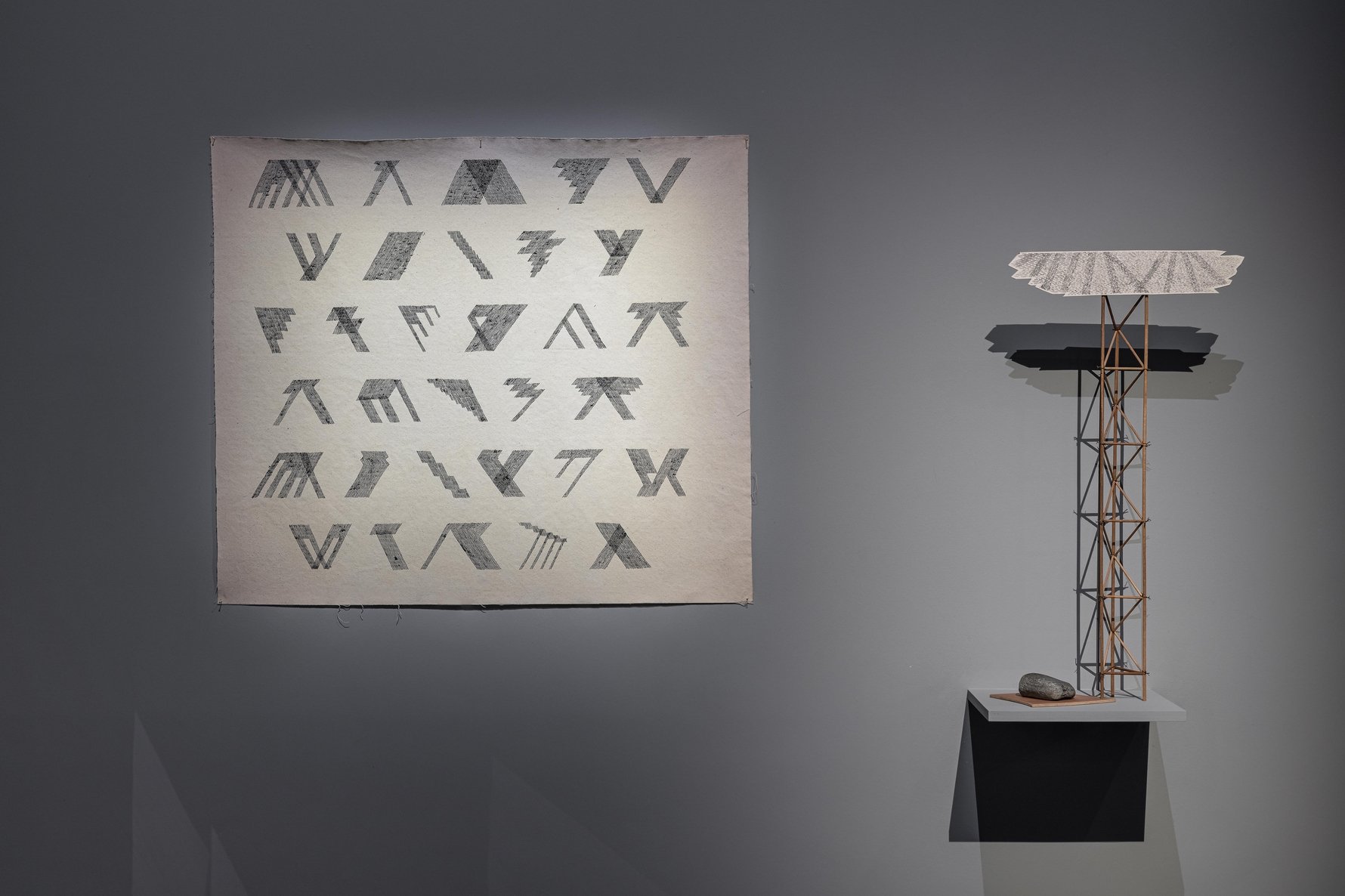
Offering his remark on Air, singular Cape Town practitioner Jonah Sack’s Thunderstorm Typology and Cloud Tower are the artist’s way of codifying water vapour and droplets of rain. In the latter sculptural installation, improvised dowel stick scaffolding props up a hand-drawn cloud cut-out – a playful visualisation of the ordinarily invisible air particles upon which clouds appear to float.
Back down to Earth, Atmosphere 3 of Ecospheres fosters a conversation around indigenous knowledge systems, extraction, and sustainability. In the Ecospheres reader, we read of Gayatri Spivak’s distinction between “the globe” and “the earth”. According to her, “the globe” is an economic construction only on our screens – nobody lives there. “The earth” on the other hand is not only the place we inhabit physically but the soil that sustains all living plant life and ecosystems.
Zino Saro-Wiwa’s video work Karikpo Pipeline plays across five screens, where dancers perform on and around the remnants of oil infrastructure in Ogoniland, Nigeria. We see exposed pipelines, an old wellhead, and a decommissioned flow station in various states of disrepair, overgrown with thick vegetation. Saro-Wiwa makes plain the conflicts between power dynamics and cultural value systems and asks us to consider what constitutes true custodianship of the land.
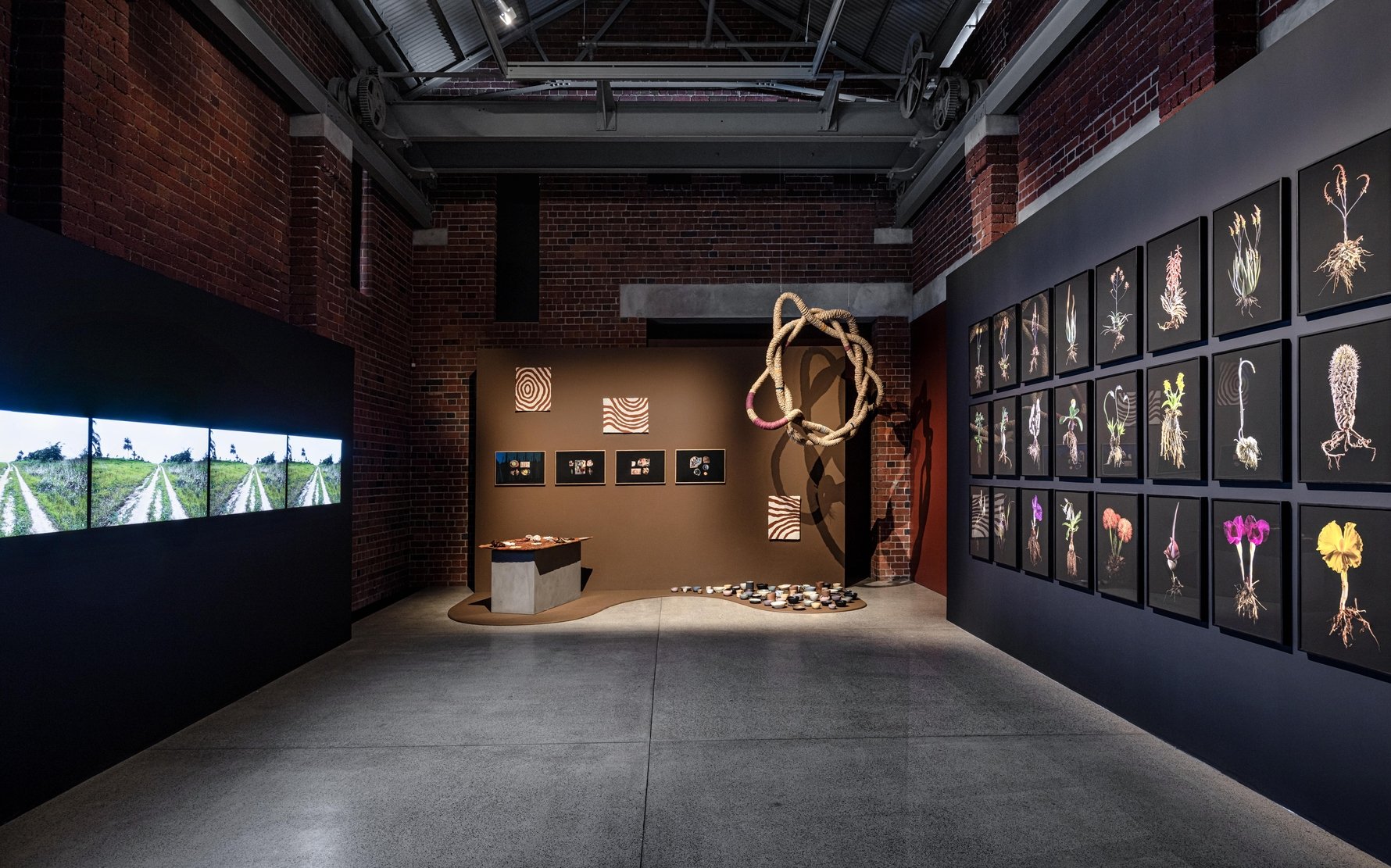
A series of collaborations with Mater Iniciativa, an interdisciplinary organisation in Peru, is a journey through ingredients, nature, and culture. The installation Territorio is a beautiful tablescape celebrating Peru’s natural abundance and diversity of ingredients. In Earthen, ceramic vessels crafted by various Peruvian artists further illustrate the generosity of the Earth, and what is possible when we work in concert with the resources available to us, transforming raw materials like clay into objects of use and beauty.
Russell Scott's crisp studio images of indigenous South African plants, mostly gathered from the Highveld region, bring the message closer to home. For the photographer, the wonder of a plant resides in all its dimensions, from the exotic blooms seen above ground to the complex root systems below the soil. Another ode to the hidden lives of plants, Ximena Garrido-Lecca's huge hydroponic garden of lima beans occupies an entire room of the museum space. One of the Peruvian varieties of this legume was believed to be used in a written communication system of the Moche culture, a pre-Incan civilisation that developed advanced irrigation systems between 100 and 850 CE. Aided by lights that mimic the sun, the beans will continue to grow in the gallery for the duration of the exhibition.
What we know, and what Ecospheres emphasises, is that ecology and human nature are not separate; they’re intimately intertwined. Our well-being stems from that of the Earth, and vice versa. Yet a symbiotic engagement with the natural world cannot be mandated. Devotion, not legislation, can reveal better, more sustainable paths forward. Relationships are at the heart of the matter. Our JCAF guide summed it up perfectly saying, “You look after what you love.”
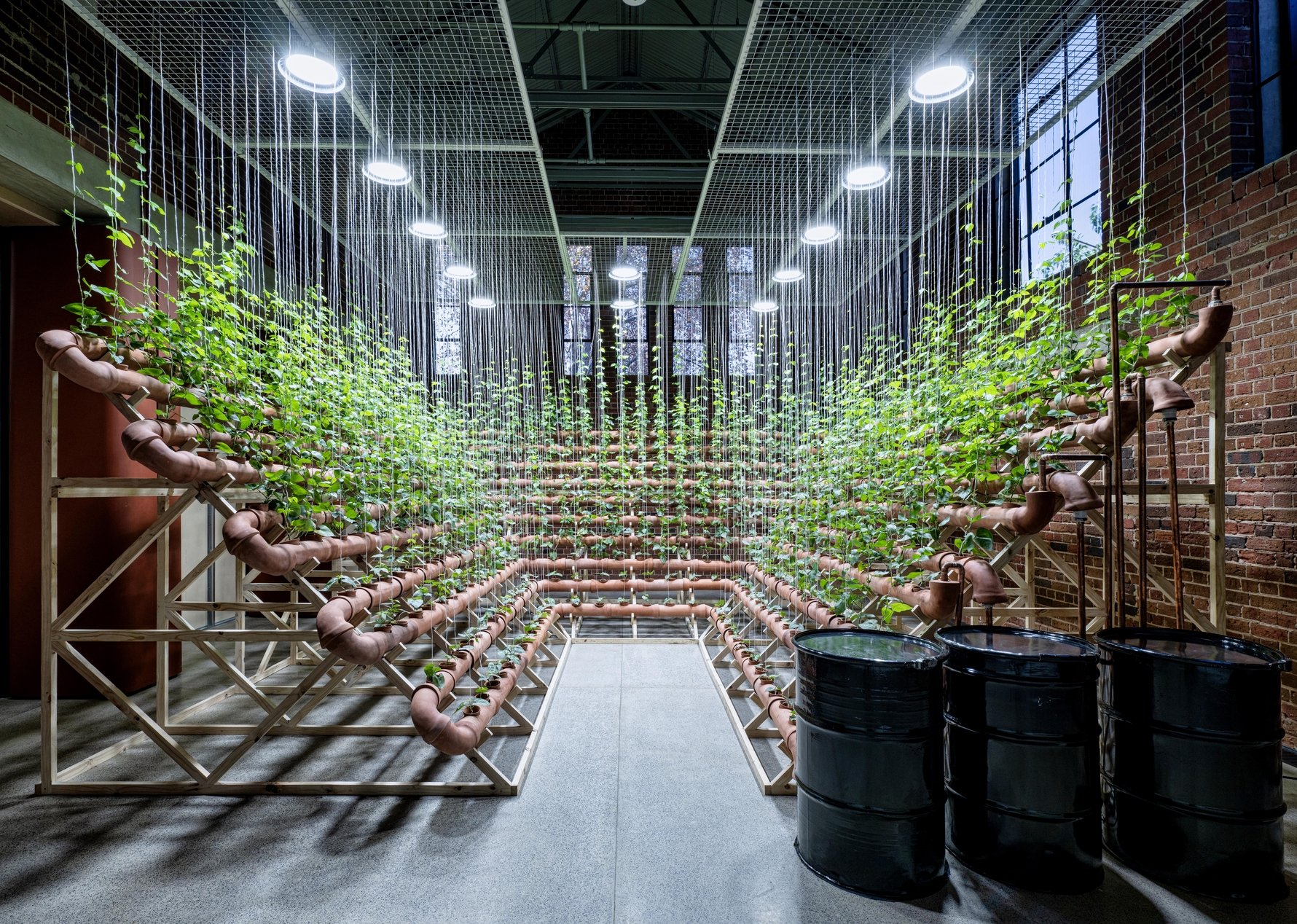
With Ecosopheres, we see the largest collection of artists assembled for a JCAF exhibition to date. While the show deals with the weighty matter of our place on Earth, it has a wonderful lightness to it – perhaps that's the impact of bringing nature, the most graceful of teachers, into the gallery space.
Part of their unique visitor experience, JCAF's exhibitions are all guided in small groups, so advance bookings are required. The tours are consistently excellent, illuminating the many threads that surround and connect the works on show. The beautifully put-together Ecospheres reader, which you can comb through at your leisure in the Reading Room designed by Wolff Architects, is full of insights that can guide you on your journey through this exhibition, and beyond.
Ecospheres shows at JCAF in Forest Town until Sat, Dec 7 – a long enough run to plan multiple visits as the lima beans reach their way towards the ceiling. Book your guided tour of the exhibition here.


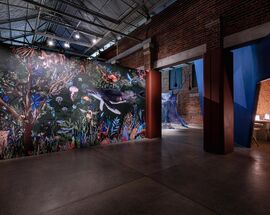

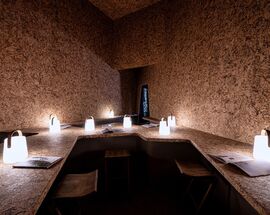


Comments